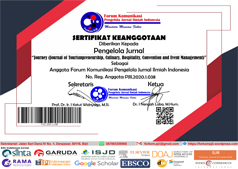The History Of Babi Guling In The Tradition Of Banten To Become A Typical Balinese Culinary
Abstract
The existence of Balinese suckling pig cannot be separated from the existence of offerings from guardians or offerings, which require using suckling pig as one of the ingredients. Babi guling is one of the important means of offering in certain temples at ceremonies asking for mass village prosperity. The tendency of the Balinese people to consume Babi Guling in the past cannot be separated from the blessings of offerings (paridan or prasadam) because many Hindu ceremonies in Bali use Babi Guling as a ceremony, and after it is offered it must be enjoyed and grateful for as a blessing. Starting from the tradition of offerings, but in line with the development of the paradigm of cultural commodification in Balinese society, then transformed into a commercial commodity for suckling pig culinary menu, which is sold to the public every day. This study aims to find out the historical traces of suckling pig in the offering tradition of Hindus in Bali and to find out the religious function of suckling pig in Hinduism so that it becomes one of Balinese specialties. This type of research is descriptive analytic with in-depth analysis techniques. This study concludes that the historical traces of suckling pig in the Hindu tradition of offerings until it develops as a typical Balinese culinary business commodity which is currently rife cannot be separated from the factors of natural resources, climate and Balinese culture in the past. The use of pork as a means of offering cannot be separated from the influence of the Bairawa and tantrayana sects where the worship of Durga has been strengthened again, which has resulted in the strengthening of the culinary position of pork as a complement to the religion of Hindus in Bali, especially in Galungan celebrations until now.
















